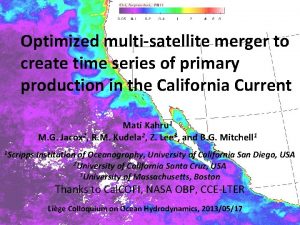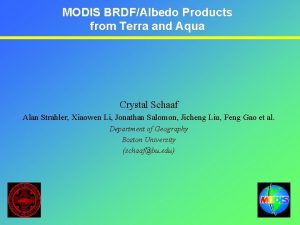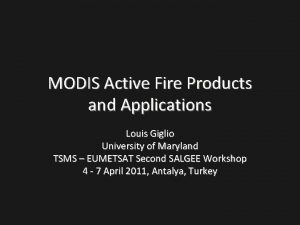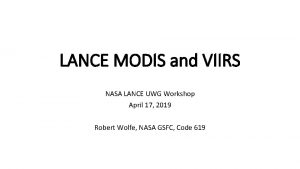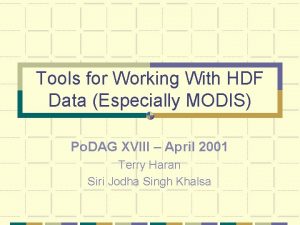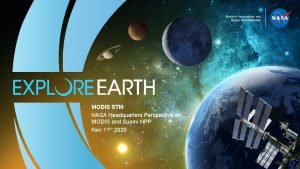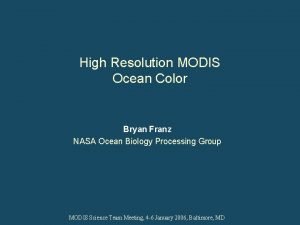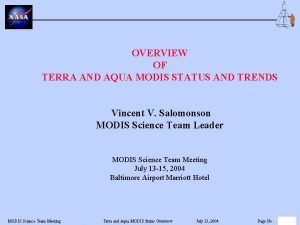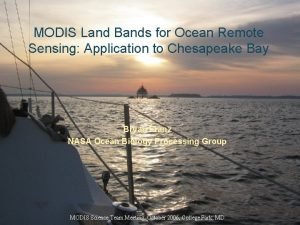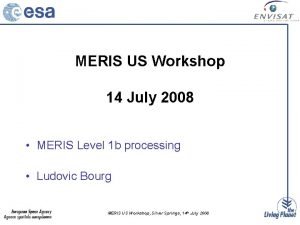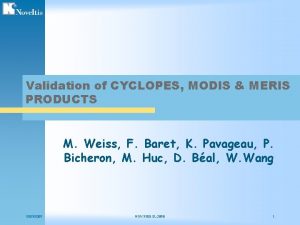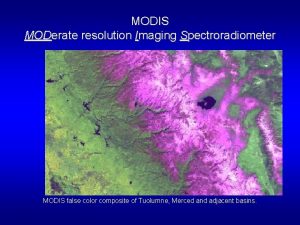Evaluating OLCI MERIS MODIS ocean color products to








- Slides: 8

Evaluating OLCI, MERIS, & MODIS ocean color products to advance watershed monitoring & time-series applications P. J. Werdell 1, B. N. Seegers 1, C. W. Proctor 1, T. Owens 1, R. P. Stumpf 2, B. A. Schaeffer 3, K. Loftin 4 1 Ocean Ecology Laboratory (616) NASA GSFC, 2 NOAA, 3 U. S. EPA, 4 USGS Figure 1 Figure 2 The Cy. AN Project (EPA, NASA, NOAA, USGS) uses ESA/Copernicus MERIS & OLCI data products to identify harmful cyanobacteria blooms in U. S. inland lakes. MERIS & OLCI data records do not overlap; thus, we use MODIS-Aqua & -Terra to infer their consistency. MERIS & MODIS radiometrically agree well, leading to cyanobacteria index (CI) products that also agree (Fig. 1). OLCI appears to have a high radiometric bias and, thus, produces cyanobacteria index products that are more conservative (fewer IDs) than MODIS (Fig. 2). Earth Sciences Division – Hydrosphere, Biosphere, and Geophysics

Name: Jeremy Werdell, Ocean Ecology Laboratory (616), NASA GSFC E-mail: jeremy. werdell@nasa. gov Phone: 301 -286 -1440 References: P. J. Werdell, T. Owens, C. Proctor, B. Seegers, R. Stumpf, B. Schaeffer, and K. Loftin (2018), Evaluating & achieving consistency in OLCI & MERIS ocean color products to advance watershed monitoring & time-series applications IS 41 A-04, presented at 2018 American Geophysical Union Ocean Sciences Meeting, Portland, OR, 15 Feb 2018. B. A. Schaeffer, K. Loftin, R. P. Stumpf, and P. J. Werdell (2015), Agencies collaborate, develop a cyanobacteria assessment network. EOS Trans. AGU 96, 16– 20. Data Sources: All satellite data were distributed and processed by the Ocean Biology Processing Group (616), NASA GSFC. Original data sources include NASA, ESA, and Copernicus. All in situ data were acquired from Sea. BASS (616), NASA GSFC. MOBY data were collected by NOAA. AERONET-OC data originate from various AERNOT stations, coordinated by NASA GSFC. Technical Description of Figures: Figure 1: In situ (MOBY=red, AERONET-OC=black) vs. MODIS-Aqua remote sensing reflectance at 443 nm (left). In situ (MOBY=red, AERONET-OC=black) vs. MERIS remote sensing reflectance at 442 nm (center). Cyanobacteria index (CI) products for MODIS-Terra and MERIS in Lake Erie (right). MAE is the median absolute error. Figure 2: In situ (MOBY) vs. MODIS-Aqua remote sensing reflectance at 443 nm (left). In situ (MOBY) vs. OLCI remote sensing reflectance at 443 nm (center). Cyanobacteria index (CI) products for MODIS-Terra and OLCI in Lake Erie (right). Scientific significance, societal relevance, and relationships to future missions: The Cy. AN Project (EPA, NASA, NOAA, USGS) uses 300 -m ESA/Copernicus MERIS & OLCI data products to identify harmful cyanobacteria blooms in U. S. inland lakes. Stakeholders & collaborators include regional EPA offices, state departments of natural resources, & regional watershed managers. The Cy. AN Project distributes OLCI data to these collaborators. At this time, OLCI CI data products are conservatively low (fewer positive identifications of harmful algae). Ongoing & forthcoming calibration efforts will improve OLCIs radiometric accuracy and improve its harmful cyanobacteria detection capability. With future support, the Ocean Biology Processing Group (616) will continue to evaluate & improve OLCI data products. Earth Sciences Division – Hydrosphere, Biosphere, and Geophysics

Lake Chad Total Surface Water Area Fritz Policelli 1, Alfred Hubbard 2, 3 , Hahn Jung 1, 3 , Ben Zaitchik 4 , Charles Ichoku 5 1 Hydrological 4 Depart. Sciences Lab, NASA GSFC , 2 Biospheric Sciences Lab, NASA GSFC, 3 SSAI, of Earth and Planetary Sciences, Johns Hopkins U. , 5 Climate and Radiation Lab, NASA GSFC Figure 1 Figure 2 We extended an existing time series of Lake Chad total surface water area from 13 to 28 years using MODIS Land Surface Temperature and Sentinel-1 a C-band radar data. We find for the dry seasons of 1988– 1989 to 2016– 2017 that the maximum total surface water area of the lake was approximately 16, 800 sq. km (February and May, 2000), the minimum total surface water area of the lake was approximately 6, 400 sq. km (November, 1990), and the average was approximately 12, 700 sq. km. Further, we find the total surface water area of the lake to be highly variable during this period, with an average rate of increase of approximately 143 km 2 per year. Earth Sciences Division – Hydrosphere, Biosphere, and Geophysics

Name: Fritz Policelli, Hydrological Sciences Lab, NASA GSFC E-mail: fritz. s. policelli@nasa. gov Phone: 301 -614 -6573 References: • Policelli, F. , Hubbard, A. , Jung, H. C. , Zaitchik, B. , Ichoku, C. , 2018. Lake Chad Total Surface Water Area as Derived from Land Surface Temperature and Radar Remote Sensing Data. Remote Sens. 10, 252. https: //doi. org/10. 3390/rs 10020252 • Leblanc, M. , Lemoalle, J. , Bader, J. -C. , Tweed, S. , Mofor, L. , 2011. Thermal remote sensing of water under flooded vegetation: New observations of inundation patterns for the ‘Small’ Lake Chad. J. Hydrol. 404, 87– 98. https: //doi. org/10. 1016/j. jhydrol. 2011. 04. 023 • Magrin, G. The disappearance of Lake Chad: history of a myth. J Polit Ecol 2016, 23, 204– 222. • Sarch, M. -T. ; Birkett, C. Fishing and farming at Lake Chad: Responses to lake-level fluctuations. Geogr. J. 2000, 166, 156– 172. • Okpara, U. T. ; Stringer, L. C. ; Dougill, A. J. Lake drying and livelihood dynamics in Lake Chad: Unravelling the mechanisms, contexts and responses. Ambio 2016, 45, 781– 795, doi: 10. 1007/s 13280 -016 -0805 -6. Data Sources: NASA MODIS Land Surface Temperature data, ESA Sentinel-1 a C-band radar data, Lake Chad total surface water area from Leblanc, et al. , 2011. Technical Description of Figures: Figure 1: (a) Example NASA MODIS Land Surface Temperature (LST)-derived dry season water classification (31 October 2016– 7 November 2016) (b) Example ESA Sentinel-1 a C-band radar-derived dry season water classification (5 November 2016). Figure 2: Annual mean, maximum, and minimum Lake Chad dry season total surface water area time series composite from Leblanc et al. , 2011 and Policelli et al. , 2018. Each data point represents a full month. Trend lines are included. In Figure 1 Inundated area is shown in blue and dry land in tan. The total area of water is very similar in 1 a (LST-derived water classification) and 1 b (radar-derived water classification), however the distribution is different. Given the maturity of the use of radar for classifying water, we used the radar-derived classification to adjust the LST-derived classification. This allowed us to develop a longer time series (28 years) of adjusted LST-derived water extent than was possible with radar alone. In figure 2, the time series of Lake Chad total surface water area is shown, with the maximum monthly area for each year shown in orange, the minimum monthly area for each year shown in blue, and the average monthly area for each year shown in gray. Trend lines indicate the average rate of increase of lake area. Scientific significance, societal relevance, and relationships to future missions: The time series of Lake Chad total surface water area is being used in follow-on research to develop a statistical model of Lake Chad’s annual flooding cycle. The flooding extent and timing are unpredictable and important to the estimated 2 million people living along the lake’s shoreline (Magrin, G. , 2016); a significant part of their livelihoods derives from “recession farming” in the fertile soil of previously flooded lake bed (Sarch and Birkett, 2000). Without good forecasts of the flooding cycle, poor timing or location of planting can result in the loss of crops (Okpara et al. , 2016). This research demonstrates the importance of future NASA radar missions such as NISAR for monitoring water beneath flooded vegetation. Earth Sciences Division – Hydrosphere, Biosphere, and Geophysics

New Book: Pre-Earthquake Processes-A Multidisciplinary Approach to Earthquake Prediction Studies, Editors: D. Ounounov 1, S. Pulinets 2, K. Hattori 3, and P. T. Taylor 4 1 Chapman Univ. , 2 Space Res. Inst. , 3 Chiba Univ. , 4 Geodesy & Geophysics Lab. GSFC/NASA The first scientific treatise to report comprehensively about earthquake-associated phenomena. This volume highlights some twenty recent studies that present current research and progress reports on preearthquake investigations. They are globally distributed with a majority coming from China, Japan, Russia, Taiwan and Italy. They describe the various observations being recorded and their relationship to pre-seismic activity. Some of these monitored parameters (shown above) include: observing crustal motion; radon; thermal infra red/ (VLF); magnetic anomalies; atmospheric effects including ionospheric total electron content (TEC); and recording regional seismicity in active areas. Earth Sciences Division – Hydrosphere, Biosphere, and Geophysics

Name: Patrick T. Taylor Email: patrick. taylor@nasa. gov Phone: 301 -614 -6454 Reference: AGU/Wiley Geophysical Monograph 234. Pre-Earthquake Processes-A multidisciplinary approach to earthquake prediction studies, Dimitar Ouzounov, Sergey Pulinets, Katsumi Hattori, Patrick Taylor, Editors. Data Source: The data for this volume came from various NASA and non-NASA satellites (GPS, Swarm, SAR) and other non-satellite sources (ionosondes, ocean bottom seismometers and pressure gauges, seismology stations, electro-magnetometers, radon and weather monitoring stations. ) Technical Description of Figure: Figure 1. This figure is a cartoon of the various and numerous data sources, both satellite and Earth based, used by the researchers in this volume. They come from over seven countries. The crustal cross section depicts the different tectonic processes that produce earthquakes at an idealized subduction zone or trench. Scientific Significance: This book was designed to introduce the inter-disciplinary approach towards pre-earthquake studies. Our goal is to document the latest progress made in studying pre-earthquake processes and provide a snapshot of the latest international development on a wide range of research. The peer-reviewed studies can be cited in the future journal publications and hopefully this will help satisfy skeptical scientists about the existence of physical phenomena preceding earthquakes. We expect that this book will entice others to study pre-earthquake phenomena and continue developing the interdisciplinary physical approach in exploring our changing planet and towards earthquake prediction and facilitating the education of new generation of scientists. Earth Sciences Division – Hydrosphere, Biosphere, and Geophysics

The Arctic sea ice cover of 2016: a year of record-low highs and higher-than-expected lows Alek A. Petty 1, 2, Julienne C. Stroeve 3, 4, Paul R. Holland 5, Linette N. Boisvert 1, 2, Angela C. Bliss 1, 2, Noriaki Kimura 6, and Walter N. Meier 4 1 Cryospheric Sciences Lab, NASA GSFC , 2 ESSIC, University of Maryland, 3 CPOM, University of Reading, UK, 4 National Snow & Ice Data Center, 5 BAS, Cambridge, UK, 6 AORI, Tokyo, Japan. We analyzed the seasonal state and evolution of the Arctic sea ice cover of 2016. This was a highly noteworthy year featuring record low ice extents at the start and end of the year (Figure 1), but summer ice extents that were higher than expected by most seasonal forecasts. The August sea ice was extremely unconsolidated, due in-part to two major Arctic storms. September saw a rapid refreeze in this region (Figure 2), although further south, warm fall SSTs resulted in record late refreeze. Figure 1 Figure 2 We highlighted the benefits of forecasting sea ice area, instead of extent, considering these low summer ice concentrations. Earth Sciences Division – Hydrosphere, Biosphere, and Geophysics

Name Alek Petty, Cryospheric Science Lab, NASA GSFC E-mail: alek. a. petty@nasa. gov Phone: 301. 614. 6120 References: Petty, A. A. , J. C. Stroeve, P. R. Holland, L. N. Boisvert, A. C. Bliss, N. Kimura, W. N. Meier (2018), The Arctic sea ice cover of 2016: A year of record-low highs and higher-than-expected lows, The Cryosphere, 12, 433 -452, doi: 10. 5194/tc-12 -433 -2018 Petty, A. A. , D. Schroeder, J. C. Stroeve, T. Markus, J. Miller, N. T. Kurtz, D. L. Feltham, D. Flocco (2017), Skillful spring forecasts of September Arctic sea ice extent using passive microwave sea ice observations, Journal of Geophysical Research Earth's Future, 4, doi: 10. 1002/2016 EF 000495. Markus, T. , J. C. Stroeve, and J. Miller (2009), Recent changes in Arctic sea ice melt onset, freezeup, and melt season length, Journal of Geophysical Research-Oceans, 114, doi: 10. 1029/2009 JC 005436. Cavalieri, D. , Parkinson, C. , Gloersen, P. , and Zwally, J. H (1996, updated 2016), Sea Ice Concentrations from Nimbus-7 SMMR and DMSP SSM/I-SSMIS Passive Microwave Data, Version 1, Boulder, Colorado USA: NASA DAAC at the National Snow and Ice Data Center, doi: 10. 5067/8 GQ 8 LZQVL 0 VL. Comiso, J. C. : Bootstrap Sea Ice Concentrations from Nimbus-7 SMMR and DMSP SSM/I-SSMIS, Version 2 [January 2000– December 20160], NASA National Snow and Ice Data Center Distributed Active Archive Center, Boulder, Colorado, USA, doi: 10. 5067/J 6 JQLS 9 EJ 5 HU, 2000 (updated 2017). Data Sources: Sea ice concentration data using the NASA Team (Cavalieri et al. , 1996, updated 2017) and Bootstrap (Comiso, 2000; updated 2017) processing of satellite passive microwave brightness temperature. NASA Cryospheric Sciences derived melt onset and freeze onset data (Markus et al. , 2009). Technical Description of Figures: Figure 1: Box-and-whisker plots for the period 2000– 2015 of observed monthly sea ice extent (SIE) calculated using the NASA Team sea ice concentration data. The magenta crosses and the number above the brackets (in million km 2) denote the monthly 2016 SIE, while the number in brackets gives the rank of the 2016 SIE across the 2000– 2016 period (1 represents a record low in 2016). Figure 2: August and September 2016 sea ice intensification anomalies, relative to the 2000 -2015 mean calculated using Bootstrap data. Ice intensification represents the change in concentration through the month. The black contour is the 15% ice edge. Scientific significance, societal relevance, and relationships to future missions: Providing an accurate assessment of the Arctic sea ice state, and better communicating sea ice variability/uncertainty, is of paramount importance considering the role of Arctic sea ice as an indicator of global climate change. Improving sea ice forecasts are also urgently needed for those living and operating in the Arctic. NASA sea ice data are providing crucial insight into sea ice variability and are improving sea ice forecasts, but need to be used with care. Earth Sciences Division – Hydrosphere, Biosphere, and Geophysics
